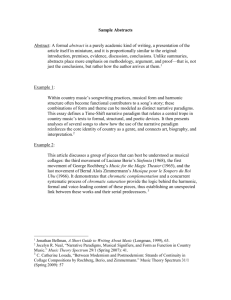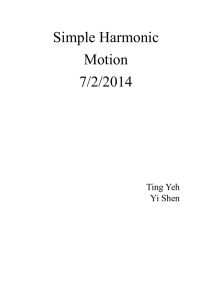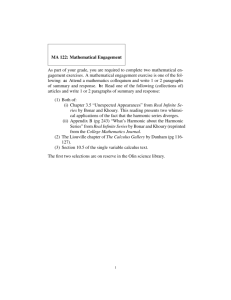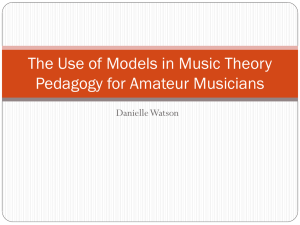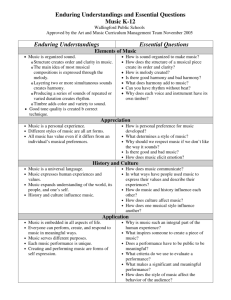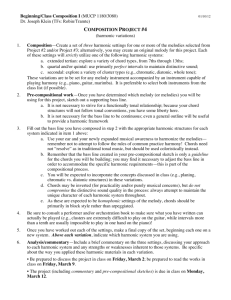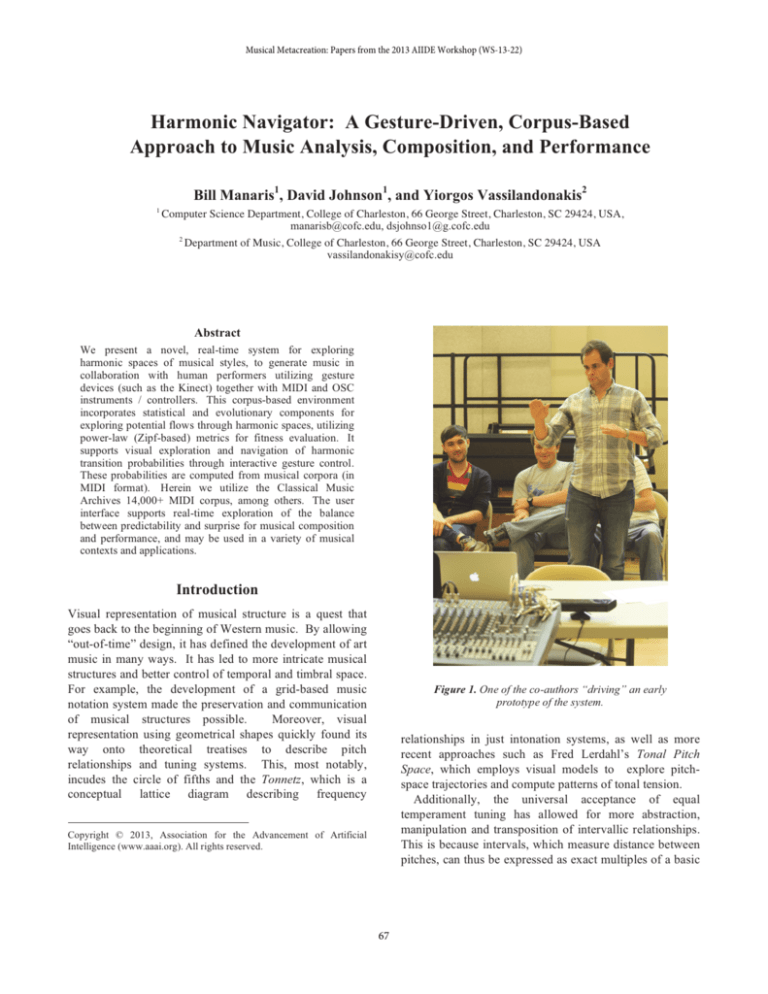
Musical Metacreation: Papers from the 2013 AIIDE Workshop (WS-13-22)
Harmonic Navigator: A Gesture-Driven, Corpus-Based
Approach to Music Analysis, Composition, and Performance
Bill Manaris1, David Johnson1, and Yiorgos Vassilandonakis2
1
Computer Science Department, College of Charleston, 66 George Street, Charleston, SC 29424, USA,
manarisb@cofc.edu, dsjohnso1@g.cofc.edu
2
Department of Music, College of Charleston, 66 George Street, Charleston, SC 29424, USA
vassilandonakisy@cofc.edu
Abstract
We present a novel, real-time system for exploring
harmonic spaces of musical styles, to generate music in
collaboration with human performers utilizing gesture
devices (such as the Kinect) together with MIDI and OSC
instruments / controllers. This corpus-based environment
incorporates statistical and evolutionary components for
exploring potential flows through harmonic spaces, utilizing
power-law (Zipf-based) metrics for fitness evaluation. It
supports visual exploration and navigation of harmonic
transition probabilities through interactive gesture control.
These probabilities are computed from musical corpora (in
MIDI format). Herein we utilize the Classical Music
Archives 14,000+ MIDI corpus, among others. The user
interface supports real-time exploration of the balance
between predictability and surprise for musical composition
and performance, and may be used in a variety of musical
contexts and applications.
Introduction
Visual representation of musical structure is a quest that
goes back to the beginning of Western music. By allowing
“out-of-time” design, it has defined the development of art
music in many ways. It has led to more intricate musical
structures and better control of temporal and timbral space.
For example, the development of a grid-based music
notation system made the preservation and communication
of musical structures possible.
Moreover, visual
representation using geometrical shapes quickly found its
way onto theoretical treatises to describe pitch
relationships and tuning systems. This, most notably,
incudes the circle of fifths and the Tonnetz, which is a
conceptual lattice diagram describing frequency
Figure 1. One of the co-authors “driving” an early
prototype of the system.
relationships in just intonation systems, as well as more
recent approaches such as Fred Lerdahl’s Tonal Pitch
Space, which employs visual models to explore pitchspace trajectories and compute patterns of tonal tension.
Additionally, the universal acceptance of equal
temperament tuning has allowed for more abstraction,
manipulation and transposition of intervallic relationships.
This is because intervals, which measure distance between
pitches, can thus be expressed as exact multiples of a basic
Copyright © 2013, Association for the Advancement of Artificial
Intelligence (www.aaai.org). All rights reserved.
67
(GA) is used to suggest interesting possibilities as the user
navigates the harmonic space.
The paper is organized as follows. Section 2 discusses
background research and related projects. Section 3
focuses on how we extract and represent harmonic data, as
well as the musical corpora used for training. Section 4
describes the user interface. It focuses on the visual
representation of the harmonic space and the transition
possibilities available, as well as the input gesture language
used to navigate and select those possibilities. The next
two sections describe how we combine Markov models
and genetic algorithms to search for interesting harmonic
sequences. Finally, we present closing remarks and ideas
for future work.
unit, the semitone. Consequently, organization of the
vertical aspect of musical texture lends itself particularly
well to visual representation.
Visual representation has traditionally been confined to
two-dimensional representation systems. Two notable
exceptions are Tod Machover’s “Harmonic Driving”, an
interactive application using a video game interface to
explore harmonic space (Paradiso 1999); and Dmitri
Tymoczko’s “Geometry of Musical Chords” (Tymoczko
2006), which provides a basis to the work presented herein.
In this paper, we explore going beyond static (or passive,
analytical) geometry to a dynamic interactive space, and
thus allow the user to interact with harmony in real time.
The term “harmony” is used throughout this paper to
describe vertical sonority, whether it appears in the form of
a traditional triadic “chord”, as codified in common
practice, or any group of pitches sounding simultaneously
as a result of independent musical gestures, commonly
found in non traditional musical textures.
Harmonic Navigator (Navigator, for sort) is the latest
system from a multi-year interdisciplinary effort exploring
artificial intelligence techniques in analysis, composition,
and performance of musical works. It is an interactive
platform for exploring harmonic spaces of distinct or
composite musical styles (controlled by the musical
corpora loaded into the system). It may be used to
compose new harmonic sequences, as well as to support
real-time performance by dynamically generating music in
collaboration with human performers (see figure 1). The
target audience for the Navigator includes composers and
performers with basic musical training (minimally, first
year music theory at the university level). There are
several possible user scenarios. One range of possibilities
includes using the Navigator to study or analyze welldefined harmonic languages, such as functional tonality,
impressionist modal styles, or more abstract harmonic
practices. Another range of possibilities includes using the
system as a harmonic experimentation tool for composing
within a specific harmonic language. This would facilitate
seeking novel yet stylistically appropriate harmonies for
diverse musical projects.
The Navigator generates harmonic sequences through
interactive user control. It combines a GUI visualization of
harmonic possibilities (i.e., how typical it is for certain
harmonies to appear next in a given harmonic sequence),
and real-time, gesture-based user input. The system is
initialized using a particular, stylistically appropriate
corpus of music, from which the system extracts harmonies
and learns harmonic transition probabilities. Currently, we
utilize the Classical Music Archives 14,000+ MIDI corpus,
along with a few smaller corpora. The Navigator combines
Markov models, genetic algorithms and power-law based
metrics for fitness evaluation. The Markov models are
used to learn harmonic transitions. A genetic algorithm
Background
Within the last 50 years there have been numerous
applications of computing and artificial intelligence in
analysis, generation, composition, and performance of
music. While these results are sometimes judged by how
close (or far) they model a human expert (strong AI), the
real contribution lies in how they may enhance human
creativity and facilitate artistic exploration and expression.
GenJam generates jazz improvisations for real time
performance (Biles 2003). GenJam is trained using an
interactive genetic algorithm which determines fitness
through a human mentor. The trained population is used
to “trade fours” with a human performer. While the
performer is playing, GenJam listens to his last four
measures, maps the measures to individuals in the GA
population and then mutates these individuals to generate
its own solo.
The Corpus-Based Harmonic Progressions Generator
(Eigenfeldt and Pasquier 2010) mixes stochastic selection,
via Markov models, and user influence to generate
harmonic progressions in real time. The user enters
information to specify harmonic complexity and tension, as
well as a bass line contour. This is used by the system to
influence the selection of harmonies from the trained
Markov models, and to generate a harmonic progression.
Experiments in Music Intelligence (EMI) is the most
comprehensive work in automated computer music
generation to-date (Cope 2004). EMI performs feature
analysis on a corpus of musical works and uses results
from this analysis to train Markov models. Using these
models, EMI can then automatically compose pieces in a
style similar to the corpus, arguably some better than
others. EMI works off-line and has been used to generate
numerous pieces in the style of various composers.
Continuator is an interactive music performance system,
which accepts musical input from a human performer. It
completes musical material in the same style as the user
68
input (Pachet 2004). Using a musical corpus, the system
trains several Markov models (of various orders),
structured in decreasing order of information retrained.
Human performer input is matched against the various
Markov models starting with the most informed one, and
continuing (by reducing the length of the user input) until a
match is found. The corresponding Markov model is used
to generate a musical continuation. This makes the system
sometimes generate perfect reproductions of earlier
musical input, and other times less accurate repetitions
(introducing interesting variations).
NEvMuse (Manaris, et al. 2007) is an experiment in
using genetic programming to evolve music pieces based
on examples of desirable pieces. NEvMuse uses artificial
music critics (employing power-law metrics) as fitness
functions. The approach was evaluated by training
artificial neural networks to predict the popularity of 2000
musical pieces with 90.70% accuracy. The system was
used to autonomously “compose” variations of J.S. Bach’s
Invention #13 in A minor (BWV 784). Similarly to
NevMuse, the Navigator’s genetic algorithm uses powerlaw metrics to determine fitness.
Monterey Mirror (Manaris, et al., 2011a) uses Markov
models, genetic algorithms and power-law metrics to
generate musical phrases, in real-time, based on musical
input from a human performer. Markov models are used to
capture short-term correlations in melodic material. The
genetic algorithm is then used to explore the space of
probable note combinations, as captured by the Markov
model, in search of novel, yet similar melodic material.
Similarity is measured using power-law metrics, which
capture long-term correlations in melodic material, i.e., the
statistical balance between expectation and surprise across
various musical parameters (e.g., Manaris et al. 2005,
2011b).
Our system’s user interface is inspired by Dasher.
Dasher is an efficient text-entry interface for motorimpaired users, driven by natural continuous pointing
gestures (Ward, Blackwell, & MacKay 2000; Ward &
MacKay, 2002). The user navigates through a space of
probable character sequences using mouse movements to
select the next character to “type”. As the user selects
characters, the display is dynamically updated with new
characters (see figure 2). Dasher uses a probabilistic
model to determine what characters should appear next,
given what has been typed so far. The most probable
alternatives are given more screen area to facilitate
selection. As predicted by Fitt’s law, this approach
improves data entry speed, while reducing error rate.
Harmonic Navigator is implemented in Jython and Java
using custom GUI and MIDI libraries. It incorporates
computational elements from NevMuse and Monterey
Mirror to allow human performers to navigate, through a
Figure 2. The Dasher GUI with the user having typed
“demonstrat” so far. The most probable sequence is
“demonstration”. Other alternatives include
"demonstrative", and "demonstrated".
Dasher-inspired interface, the space of musical harmonies
using a Kinect gesture interface.
In summary, while the Navigator has been influenced by
the other applications described above, it differs in many
ways. Most of the GA based applications are interactive,
i.e., require humans to judge the fitness of the results. This
is time consuming; also, it may produce inconsistent
results due to user fatigue. Our system uses power-law
metrics to automatically determine fitness. It also takes an
interactive approach to give users an environment to
express their own creativity in selecting harmonic
progressions, while also presenting suggestions from its
generative algorithms.
Harmonic Space Representation
From a music theory standpoint, harmony has played a key
role in formal construction and narrative in both tonal and
non-tonal systems. Furthermore, harmonic context not
only defines musical texture by contextualizing lines
(melodies) and creating consonance/dissonance hierarchy,
but also, across time, it outlines formal trajectories,
controls pacing and phrasing, as well as levels of tension
and release. Well-established pitch systems have strong
harmonic syntax, which dictates how strongly or loosely
vertical sonorities (chords) can be connected in sequence.
This syntax in some styles (e.g., common practice
functional tonality) is as strong as in natural language, with
chords assigned specific functions (much like nouns being
69
we calculate probabilities of harmonic transitions), we try
to simplify and normalize the information at hand.
For each MIDI piece, we calculate the average note
duration across the whole piece and set a duration
threshold to remove notes that are too small to be part of
harmonic voicings (e.g., passing or neighbor tones). This
is a parameter that can be set by the user, during training of
the system, and is experimentally determined based on the
musical style.
Next, we perform voice separation using our
implementation of the Chew and Wu (2004) algorithm.
This algorithm separates a piece into contiguous sequences
of melodic phrases, by connecting melodic fragments using
a shortest-distance approach. Evaluation experiments
indicate a high success rate in identifying individual voices
from MIDI material (ranging from 88.98% to 99.75%
depending on the particular metric).
Melodic phrases are canonicalized, by converting the
MIDI pitch data into a canonical form that disregards key
information. To do so, we calculate the key of the piece by
creating a histogram of pitch-durations. We assume the
most frequent pitch class (total durations) is the key
(regardless of octave).1 Next, from the various instances of
the pitch class across octaves (e.g., C3, C4, C5),2 we select
the most frequent one (e.g., C4) and set it as the base tone
(i.e., canonical pitch 0). All other pitches (MIDI numbers)
in the piece are replaced by the difference between their
MIDI pitch number and the MIDI pitch number of the base
tone. For example, if a piece begins with C4, D4, B3 (and
assuming C4 is the base tone), it is converted to 0, 2, -1.
Then we extract harmonies. For our purposes, a
harmonic interval is any interval between two notes that
overlap.
subjects or objects in a phrase), hierarchy, weight and even
punctuation. Thus, a musical phrase may close with a
cadence (a codified chord sequence), “the basis of all
Western musical form starting with Gregorian chant”
(Rosen, 1971). Within such a pitch system, the listener is
guided and can orient themselves by the harmonic flow,
which also sets up expectations for what is to follow and
how long a specific phrase will be. Of course, this opens
the door for introducing surprises, such as deceptive
cadences (e.g., V-vi), or even modulations to new tonal
centers (Schoenberg 1954).
In this context, the Navigator allows a user who is
familiar with the musical style at hand to meaningfully
interact with upcoming harmonies (much like a Dasher
user), selecting chords that have strong probability of
connecting well to the existing sequence of chords (i.e., the
harmonic sequence context), or possibly go to unexpected
harmonic places.
Musical Training Corpora
We are currently using the Classical Music Archives
(CMA) corpus, which consists of 14,695 classical MIDI
encoded pieces. This corpus is augmented with 500+
MIDI pieces from other music genres including Jazz,
Rock, Country, and Pop, as well as 371 MIDI pieces of the
Riemenschneider collection of Bach chorales (a total of
approximately 15,600 music pieces).
Stylistic integrity is paramount when selecting pieces to
be used with our system. For instance, combining 12-tone
pieces with Renaissance pieces would most likely create a
harmonic space with two disjoint subspaces. This is
undesirable, if not pointless.
On the other hand,
combining, say, modal Jazz with impressionist pieces (e.g.,
Debussy) might create a somewhat coherent harmonic
space, which may be interesting to investigate and
navigate.
Additional experiments are being conducted with
musical corpora in MP3. Our team has developed an
automated audio-to-MIDI transcription system, based on
the Constant Q Transform algorithm (Brown and Puckette
1992), which is being used in the Armonique musical
search engine (Manaris, et al. 2011b). Another system we
are experimenting with is WIDI (www.widisoft.com).
Although these solutions are not perfect (i.e., they
introduce transcription errors and musical “noise”, such as
extra, “ghost” notes), we are exploring various filtering
techniques to extract relevant harmonic data for use with
the Navigator.
Data Representation
For each harmonic interval, we store (i1, i2, …, in), where i
represents the interval from the piece’s base tone.
For example, consider the following two harmonies
from a piece with base tone C4:
Harmony 1: (C3, C4, E4, G4, B4)
Harmony 2: (D4, FS4, A4, CS5)3
Using the above process, these harmonies would be
represented as:
1
Even for pieces with modulations, the pitch class with the longest
accumulated duration (across the piece) defines the tonic center of that
piece.
2
C4 represents the pitch C in the 4th octave (i.e., MIDI pitch 60).
3
FS4 is the pitch F sharp, 4th octave (i.e., MIDI pitch 66).
Harmony Extraction
Harmony extraction is a difficult problem even in MIDI
musical corpora. Since our task is statistical in nature (i.e.,
70
Harmony 1: (-12, 0, 4, 7, 11)
Harmony 2: (2, 6, 9, 13)
where the first number, -12, represents the root of the first
harmony (C4), which has -12 distance from the piece’s
base tone. The other four numbers, (0, 4, 7, 11), are the
corresponding pitch distances (intervals) from the piece’s
base tone. This representation is complete, i.e., it can
represent all harmonies (even dissonant ones), and is
consistent with music theory, including (Tymoczko 2006).
The advantage of the latter is that it defines an
aesthetically-relevant notion of harmonic distance across
chords. Also, it allows us to define interval-based Zipf
metrics for use in the fitness function of our genetic
algorithm (discussed later).
Figure 3. The Harmonic Navigator user interface
(colors adjusted for grayscale printing).
Gesture Interface
The development of gesture devices (such as the Kinect)
has opened new avenues for hands-free, gesture-based user
interfaces. Currently, many implementations of gesture
languages are based on the point-and-click (mouse)
metaphor. However, we need to move beyond point-andclick, in order to utilize the full interaction-design potential
of this novel gesture-interface paradigm (Francese, et al.
2012).
they are arranged around a smaller clock face. The size
(radius) of this clock face corresponds to the sum of the
enclosed harmonies’ probabilities. Hovering the cursor
over this clock face zooms in to display a larger version of
the clock face, which presents more information about the
contained harmonies, and allows the user to select one. The
placement of these harmonies inside the smaller clock face
is determined by the second pitch in the harmony.
In the case where multiple harmonies have the same
second pitch, these harmonies will also be placed inside an
even smaller clock. This hierarchical (recursive, fractallike) grouping continues until all harmonies can be
represented individually. Similarly to binary search, this
hierarchical decomposition/organization of the harmony
palette allows the user to quickly “home in” on a desired
harmony. The user efficiency gained by this approach
(over a linear, non-hierarchical placement of harmonies
around a single clock face) is O(log12 n), where n is the
number of follow-up harmonies (and base 12 given the
decomposition of the search space into 12 regions, at each
level).
Similarly to Monterey Mirror, a genetic algorithm runs
continuously (in the background) to suggest interesting
harmonic flows. The follow-up harmony (or harmonies)
selected by the genetic algorithm is (are) identified by a
special color (e.g., gold) settable by the user. We are
exploring other possibilities (e.g., a thicker border).
In accordance with HCI guidelines (e.g., Dix et al.
1998), we use color redundantly, i.e., to emphasize
information already present at the interface.
Color
assignment of circle-harmonies is based on intervallic
tension. Intervallic tension is already visible on the
interface, through the displayed harmonic intervals
User Interface Design
The Navigator’s interface presents available harmonies as
a dynamic navigable space, similarly to Dasher. While
Dasher presents follow-up characters in a 2D left-to-right
navigation space, we utilize a 3D front-to-back approach.
The interface presents users with a harmonic palette,
from which to choose a follow-up harmony (see figure 3).
The palette contains a number of circles, each representing
a harmony. The current harmony is located in the center of
the display. Follow-up harmonies are determined by the
current harmony (as dictated by the training corpus), and
are placed in a clockwise fashion, around a clock face
labeled with the 12 tones. (Since pieces are normalized, C
is 0.) Harmonies are represented by vertically stacked
numbers stating harmonic intervals. This is consistent with
(and provides the same information as) the vertical
placement of notes on a staff. 4
Similarly to Dasher, the size (radii) of follow-up circleharmonies corresponds to transition probabilities from the
current harmony (the larger, the more probable).
When there are multiple follow-up harmonies with the
same root pitch (e.g., see E and A root pitches, in figure 3),
4
Arguably, in a more direct (usable) manner, given our target users.
71
(especially for expert musicians). Color assignment makes
that information more visible to non-experts.
Intervallic tension of a chord is determined by two
factors. One is the intervallic content of the chord - a
chord with more tense intervals has a higher tension factor,
and thus sounds more dissonant. The relaxation vs. tension
of the chord is mapped to cool vs. warm colors on a color
wheel (i.e., blues are cool (relaxed) and reds or yellows are
warm (tense)).5
Once again, it should be noted that this UI was designed
for users with, at least, basic training in functional tonality
(first-year college harmony, or equivalent). However, as
we collect usability feedback from more users, this UI may
evolve (e.g., to provide more or, even, less information).
In particular, moving backwards allows the user to step
back to previous harmony selection points, and try other
alternatives. While this may seem peculiar during live
performance, it may be utilized creatively (not unlike
sound looping, and/or “scratching” by DJs). On the other
hand, this is quite natural for composition tasks (i.e.,
“should I use this harmony or that?” or “what harmonic
choices would I have here, had I gone to a relative minor
three chords ago?”).
Statistical Modeling
Harmonic Navigator uses Markov models to construct an
n-dimensional matrix of how often one subsequence of
harmonies resolves into a given harmony. Once trained,
the system can be used (via the Kinect interface) to
generate various harmonic sequences (or harmonic flows)
that are derived from the training corpus.
It is possible for the system to recreate an exact training
sequence (i.e., recreate the harmonies in a musical piece
used for training). This is more probable for smaller
training sets, as a Markov model would mostly memorize
separate (disconnected, independent) sequences. However,
as the training set grows and introduces ambiguity (i.e.,
training sequences overlap across different places),
generating exact training sequences becomes exponentially
improbable. This is where the power of the Navigator lies,
i.e., to facilitate exploration and discovery of novel
harmonic flows that are probabilistically plausible (at least,
at a local level) and are stylistically consistent with the
training corpus. We have found that, in practice, Markov
orders of 1, 2 or 3 work well. Higher orders may result in
memorization of harmonic sequences, and thus reduce the
potential for discovery of novel harmonic ideas.
Kinect-Based Gesture Language
We identified three main user tasks that the Navigator’s
interface needs to support for harmonic navigation. These
are “explore the current harmony palette”, “select a followup harmony”, and “backtrack” (i.e., unselect current
harmony and return to the previous palette).
Our current prototype is implemented using a Kinect
controller. Given this, we have devised the following
gesture language to implement the above user tasks. (We
are also exploring gesture languages for other controllers,
such as the Leap Motion sensor and OSC control via
smartphone.) The Kinect gesture language utilizes only
one hand via three gestures (freeing the second hand for
other activities, such as interacting with MIDI and OSC
controllers):
• Hand Movement in the X-Y Plane – Moving the
hand left-to-right and up-to-down moves the cursor
around the display. This action supports exploration
of the current harmony palette (e.g., hovering over a
secondary clock face to enlarge it).
Evolutionary Recommendations
• Hand Push – Pushing towards a follow-up harmony
selects it. This moves the selected circle-harmony to
the center, begins sounding the corresponding
harmony (via MIDI), and displays the next harmony
palette. This action supports moving forward in the
harmonic space.
The Navigator utilizes a genetic algorithm to discover
interesting harmonic choices (and present them), as the
user navigates a harmonic space. Aesthetic interest is
guided by a fitness function using power-law metrics (see
below). The fitness function may also incorporate a
melodic contour, as in (Eigenfeldt and Pasquier 2010), to
provide a high-level structure and impose melodic
constraints to the exploration. In this case, harmonies
would be chosen by the GA based on how well they fit the
provided contour. This may be useful to prune large
harmonic spaces (i.e., spaces generated from large training
corpora). However, it may be too restrictive for smaller
corpora, where there may not be enough harmonic material
to fit the melodic contour.
The GA continuously computes the remaining harmonic
flows from the current harmony. Every time the user
• Hand Wave – Waving over the current circleharmony (center of the display), stops sounding it,
and returns to the previous harmonic palette (to
possibly try something else). This action supports
moving backward in the harmonic space.
5
At the time of this writing, we are still exploring various color schemes.
72
makes a new selection (and thus changes the harmonic
context), the genetic pool is updated and the GA is
restarted. This allows new possibilities to be explored and
presented. Harmonies in the GA’s elite part of the
population are presented at the UI identified by a special
color (as mentioned earlier).
It should be noted that these GA-generated flows are not
necessarily the most probable ones (i.e., as would be
produced by the Markov model). Instead, they are evolved
and evaluated for fitness using power-law metrics (and,
potentially, a melodic contour). However, these flows are
consistent with the Markov model, i.e., they are built only
of harmonic transitions found in the training corpus.
sequences) that are consistent with the Markov model (i.e.,
they could have been derived by the Markov model itself):
Power-Law Metrics
The genetic algorithm uses power-law metrics to derive a
measurement from a target piece. Fitness is determined by
the proximity of the measurements of evolved individuals
to the target piece’s measurement.
• The mutation operator randomly selects a point in the
genotype and replaces the remainder with a partial
flow generated from the Markov model.
• The crossover operator randomly selects a common
subsequence (pivot point) in two individuals
(parents) and swaps the corresponding parts. The
length of the pivot subsequence is consistent with the
Markov order, i.e., the two children could have been
generated by the Markov model.
Power laws are statistical models of proportions exhibited
by various natural and artificial phenomena. Zipf’s law is
a special type of a power law, where the probability of a
certain event occurring, P(f), is related to the frequency of
occurrence, f, by the following equation:
P(f) = 1/f
Conclusion and Future Work
We have presented the Harmonic Navigator, a gesturebased interactive system for exploring harmonic spaces of
distinct (or composite) musical styles, and for dynamically
generating music in collaboration with human performers.
We have also presented one possible user interface.
The Harmonic Navigator may be used to explore
compositional ideas in harmonic spaces derived from
various musical corpora. These corpora could be used to
derive traditional harmonies to be evaluated on a
consonance/dissonance scale (Hindemith 1945). This
approach could also be expanded to more dense harmonies,
which
can
be
similarly
evaluated
on
a
consonance/dissonance scale (Legname 1998). The only
constraint is that the corpora contain enough musical
pieces (for harmonic variety) and are stylistically
consistent (although merging of interesting styles that
share common harmonic traits is supported).
Another possibility is to revitalize traditional classroom
training in tonal harmony via tonal harmony games.
“Players” could interactively assign appropriate tonal
function and hierarchy to each important pitch in a melody:
tonic, predominant or dominant (Berry 1976), and then
select from a variety of available chords in various
inversions.
Finally, the Harmonic Navigator could be used in
musical happenings, together with MIDI and OSC
controllers, as well as traditional instruments, to create
harmonic contexts for improvised performances. This can
also inspire musical games (e.g., the system could be
driven through audience participation) to engage, inspire,
and possibly challenge musicians in various performance
environments.
(1)
This equation describes a unique property of Zipfian
phenomena, where the 2nd most frequent event appears 1/2
as many times as the 1st most frequent event; the 3rd most
frequent event appears 1/3 as many times; the 4th appears
1/4 as many times, and so on. This intriguing relationship
(regularity) is found in many human and natural
phenomena.
Music, in particular, exhibits near-Zipfian proportions
across many dimensions (e.g., pitch, duration, harmonic
intervals, distance of repeated notes, etc.). Moreover,
power-law behavior (e.g., numeric deviations from the
ideal Zipfian proportions) across a multitude of attributes
has been shown to be of aesthetic significance (Manaris, et
al. 2005, 2007, 2011b). Power-law proportions (i.e.,
vectors of power-law measurements across numerous
dimensions) extracted from musical pieces have been used
successfully in previous research to identify contextual
information of a given piece, such as author and genre.
Power-law metrics capture longer-term correlations in
harmonic flow structure. On the other hand, Markov
models capture shorter-term correlations.
Genotype Representation
Each genotype represents a particular harmonic flow (i.e.,
a sequence of chord choices), which can be generated by
the Markov model. The genetic population is initialized by
using the Markov model.
The genetic algorithm utilizes mutation and crossover
operations to always evolve individuals (harmonic
73
Acknowledgements
Manaris, B., Roos, P., Machado, P., Krehbiel, D.,
Pellicoro, L., and Romero, J. 2007. A Corpus-Based
Hybrid Approach to Music Analysis and Composition.
Proceedings of 22nd Conference on Artificial Intelligence
(AAAI-07): 839-845. Vancouver, BC.
This work has been supported in part by NSF (grants IIS0736480, IIS-0849499 and IIS-1049554) and a donation
from the Classical Music Archives. The authors would
like to acknowledge Dana Hughes for correcting MIDI
transcription errors in the 371-piece Riemenschneider
corpus of Bach chorales. Also, Dana Hughes and Kenneth
Hanson for their contributions to the custom Jython
libraries used in this project.
Manaris, B., Hughes, D., and Vassilandonakis, Y. 2011a.
Monterey Mirror: Combining Markov Models, Genetic
Algorithms, and Power Laws. Proceedings of 1st
Workshop in Evolutionary Music, 2011 IEEE Congress on
Evolutionary Computation (CEC 2011): 33-40. New
Orleans, LA, USA.
Manaris, B., Roos, P., Krehbiel, D., Zalonis, T., and
Armstrong, J.R. 2011b. Zipf’s Law, Power Laws and
Music Aesthetics, in T. Li, M. Ogihara, G. Tzanetakis
(eds.), Music Data Mining: pp. 169-216. CRC Press Taylor & Francis.
Pachet, F. 2004. Beyond the Cybernetic Jam Fantasy: The
Continuator. IEEE Computer Graphics and Applications
24(1): 31-35.
Paradiso, J. A. 1999. The Brain Opera Technology: New
Instruments and Gestural Sensors for Musical Interaction
and Performance. Journal of New Music Research 28(2):
130-149.
Rosen, C. 1971, The Classical Style; Haydn, Mozart,
Beethoven. W.W. Norton & Co,: 26.
References
Berry, W.T. 1976. Structural Functions in Music, Prentice
Hall.: 40-57.
Biles, J. A. 2003. GenJam in Perspective: A Tentative
Taxonomy for GA Music and Art Systems. Leonardo
36(1): 43-45.
Brown, J.C. and Puckette, M.S. 1992. An Efficient
Algorithm for the Calculation of a Constant Q Transform.
Journal of the Acoustical Society of America 92(5): 2698–
2701.
Chew, E. and Wu, X. 2004. Separating Voices in
Polyphonic Music: A Contig Mapping Approach.
Proceedings of 2nd International Symposium on Computer
Music Modeling and Retrieval (CMMR-04): 1-20.
Cope, D. 2004. Virtual Music: Computer Synthesis of
Musical Style. MIT Press.
Dix, A., Finlay, J., Abowd, G, and Beale, R. 1998),.
Human-Computer Interaction,. 2nd ed., Prentice Hall: 198.
Schoenberg, Arnold 1954, Structural
Harmony. W.W. Norton & Co: 192-196.
Functions
of
Tymoczko, Dmitri 2006. The Geometry of Musical
Chords. Science 313: 72-74. Sheridan Press.
Ward, D., Blackwell, A., and MacKay, D. 2000. Dasher - a
Data Entry Interface Using Continuous Gestures and
Language Models. Proceedings of the 13th Annual ACM
Symposium on User Interface Software and Technology
(UIST 2000): 129-137. San Diego, CA.
Ward, D., and MacKay, D. 2002, Fast Hands-free Writing
by Gaze Direction. Nature 418: 838-840.
Wessel, D. and Wright, M. 2002. Problems and Prospects
for Intimate Musical Control of Computers. Computer
Music Journal 26(3): 11-22.
Francese, R., Passero, I., and Tortora, G. 2012. Wiimote
and Kinect: Gestural User Interfaces add a Natural Third
Dimension to HCI, Proceedings of the International
Working Conference on Advanced Visual Interfaces (AVI12): 116-123.
Hindemith, P. 1945. The Craft of Musical Composition,
Schott: 87-89.
Legname, O. 1997. Density Degree of Intervals and
Chords. 20th Century Music 4(11): 8-14.
Lerdahl, F. 2001. Tonal Pitch Space. Oxford University
Press.
Manaris, B., Romero, J., Machado, P., Krehbiel, D., Hirzel,
T., Pharr, W., and Davis, R.B. 2005. Zipf’s Law, Music
Classification and Aesthetics. Computer Music Journal
29(1): 55-69. MIT Press.
74

